
Stone is a village and former civil parish, now in the parish of Stone with Bishopstone and Hartwell, in Buckinghamshire, England. It is located southwest of the town of Aylesbury, on the A418 road that links Aylesbury to Thame. Stone with Bishopstone and Hartwell is a civil parish within Buckinghamshire district and also incorporates the nearby settlements of Bishopstone and Hartwell.
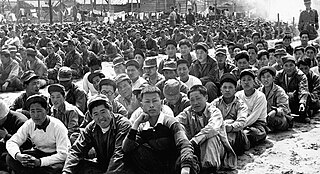
A prisoner-of-war camp is a site for the containment of enemy fighters captured as prisoners of war by a belligerent power in time of war.

Island Farm, also called Camp 198, was a prisoner of war camp on the outskirts of the town of Bridgend, South Wales. It hosted a number of Axis prisoners, mainly German, and was the scene of the largest escape attempt by German POWs in Britain during World War II. Near the end of the war it was renamed Special Camp XI and used to detain many senior SS military leaders who were awaiting extradition to the Nuremberg trials.

Camp Randall was a United States Army base in Madison, Wisconsin, the largest staging point for Wisconsin troops entering the American Civil War. At this camp fresh volunteers received quick training before heading off to join the Union Army. Also located on the grounds were a hospital and briefly a prisoner-of-war camp for captured Confederate soldiers.
Eden Camp Modern History Museum is a large Second World War-related museum near Malton in North Yorkshire in England.

Bigby is a village and civil parish in the West Lindsey district of Lincolnshire, England.

The Bowmanville POW camp, also known as Camp 30, was a Canada administered POW camp for German soldiers during World War II located on 2020 Lambs Road in the community of Bowmanville, Ontario in Clarington, Ontario, Canada. In September 2013, the camp was designated a National Historic Site of Canada.
Sunny Hill is a southern suburb of the city of Derby, England, situated mainly along the Stenson Road. It lies between the Derby City districts of Normanton and Littleover, and, to the south, Sinfin, and the parish of Stenson Fields in South Derbyshire district.
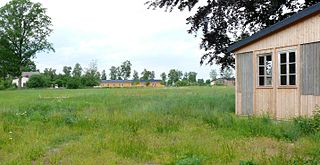
Stalag X-B was a World War II German prisoner-of-war camp located near Sandbostel in Lower Saxony in north-western Germany. Between 1939 and 1945 several hundred thousand POWs of 55 nations passed through the camp. Due to the bad conditions in which they were housed, thousands died there of hunger, disease, or were killed by the guards. Estimates of the number of dead range from 8,000 to 50,000.

Sedrup is a hamlet in Buckinghamshire, England. It is located south west of the town of Aylesbury, close to the villages of Stone, Bishopstone and Hartwell which also provide the name of the civil parish within which Sedrup lies.

Camp Concordia was a prisoner-of-war camp operating from May 1943 to November 1945, located two miles north and one mile east of Concordia, Kansas. The camp was used primarily for German Army prisoners during World War II who had been captured in battles that took place in Africa.
Camp Atlanta was a World War II camp for German prisoners of war (POWs) located next to Atlanta, Nebraska. Over three years, it housed nearly 3,000 prisoners. After the war, a number of soldiers and prisoners from the camp returned to live in the area.
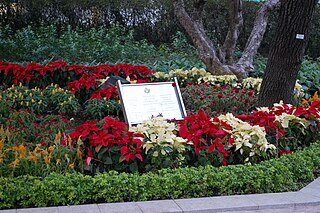
Sham Shui Po Barracks was a British Army facility built in the 1920s in the Sham Shui Po area of Kowloon, Hong Kong. The base was bounded by Fuk Wa Street to the east by Yen Chow Street and to the west by Tonkin Street and Camp Street.

Harperley POW Camp 93 is a surviving purpose-built World War II Prisoner of War (PoW) camp built to accommodate up to 1,400 inmates at Fir Tree near Crook, County Durham in the northeast of England. A work camp for low risk PoWs, it was built on a hillside overlooking Weardale and across the valley from Hamsterley Forest. It was built, initially, in 1943 by Italian PoWs to similar plans of other existing Ministry of War Standard Camps of World War II in Britain and was typical of many military installations around the country. It is the main camp for a number of satellite camps, also numbered 93. Nearby Bishop Auckland used Harperley PoWs and Oaklands Emergency Hospital was another installation numbered Camp 93.

Members of the German military were interned as prisoners of war in the United States during World War I and World War II. In all, 425,000 German prisoners lived in 700 camps throughout the United States during World War II.
Dunham Massey POW Camp was a POW camp detaining German prisoners of war. It was located in the eastern corner of Dunham Massey Home Park in an area which by the 21st century had been repurposed as a golf course and housing. Initially constructed for US Army troops, in November 1944 it began its new use and by the end of the war it held approximately 6,000 prisoners in 220 buildings.
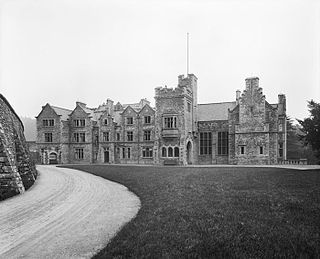
Grizedale Hall was a large country house at Grizedale, Hawkshead, in the Lake District in Cumbria, England. After two earlier Grizedale Halls had preceded, it was built anew in 1905 in the style of Gothic Revival architecture. During World War II it became No 1 Prisoner-of-war camp to hold German officers and was finally pulled down in 1957.
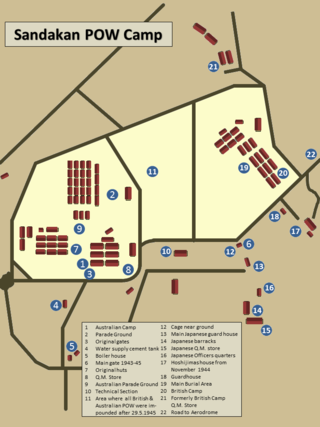
The Sandakan camp, also known as Sandakan POW Camp, was a prisoner-of-war camp established during World War II by the Japanese in Sandakan in the Malaysian state of Sabah. This site has gained notoriety as the Sandakan Death Marches started from here. Now, part of the former site houses the Sandakan Memorial Park.
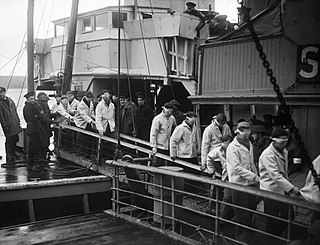
Large numbers of German prisoners of war were held in Britain between the outbreak of the Second World War in September 1939 and late 1948. Their numbers reached a peak of around 400,000 in 1946, and then began to fall when repatriation began. The experiences of these prisoners differed in certain important respects from those of captured German servicemen held by other nations. The treatment of the captives, though strict, was generally humane, and fewer prisoners died in British captivity than in other countries. The British government also introduced a programme of re-education, which was intended to demonstrate to the POWs the evils of the Nazi regime, while promoting the advantages of democracy. Some 25,000 German prisoners remained in the United Kingdom voluntarily after being released from prisoner of war status.
Lodge Moor was a British military camp based near Redmires Reservoirs, Sheffield, that was best known for housing prisoners of war during World War II. It held approximately 11,000 at its peak, mostly Germans. It was established in World War I for training purposes.















